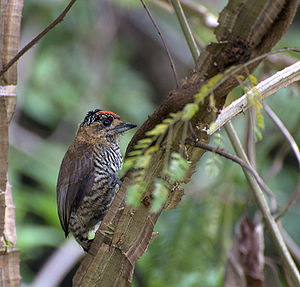Dwarf woodpeckers
| Dwarf woodpeckers | ||||||||||
|---|---|---|---|---|---|---|---|---|---|---|

Banded dwarf woodpecker ( Picumnus temminckii ) |
||||||||||
| Systematics | ||||||||||
|
||||||||||
| Scientific name | ||||||||||
| Picumninae | ||||||||||
| GR Gray , 1840 |
The miniature woodpeckers (Picumninae) - also known as soft-tailed woodpeckers - are a subfamily of the woodpecker family (order of the woodpecker birds ). In contrast to the real woodpeckers , the dwarf woodpeckers do not have a support tail because their tail feathers are not stiff enough. Since their beak is not that stable, they do not build their own breeding holes themselves, but use abandoned woodpecker holes. They are characterized by a relatively large head and a long tongue. They move similarly to the nuthatches and feed mainly on insects that they find under dead tree bark. A special feature is the zygodactyle arrangement of the toes - with two toes pointing forward and two pointing backwards. The representatives of the dwarf woodpeckers have sizes of approx. 10 cm and are therefore much smaller than their relatives of the real woodpeckers. Their habitat are tropical forests. The species of the genus Picumnus are common in South and Central America. The genus Sasia includes one African and two Asian species. A separate subfamily has now been proposed for the genus of the hopping woodpecker (Nesoctites), which occurs in the Caribbean (Benz et al. , 2006).
Systematics
The subfamily of the dwarf woodpeckers contains the following genera:
-
Little woodpeckers ( Picumnus ) - 27 species
- White- scale dwarf woodpecker ( Picumnus albosquamatus )
- Golden-browed dwarf woodpecker ( Picumnus aurifrons )
- Yellow-bellied dwarf woodpecker ( Picumnus castelnau )
- Cinnamon Woodpecker ( Picumnus cinnamomeus )
- Zebra dwarf woodpecker ( Picumnus cirratus )
- Orbigny woodpecker ( Picumnus dorbygnianus )
- Golden-scale dwarf woodpecker ( Picumnus exilis )
- Pale dwarf woodpecker ( Picumnus fulvescens )
- Rust-naped dwarf woodpecker ( Picumnus fuscus )
- Brown-backed dwarf woodpecker ( Picumnus granadensis )
- Spotted dwarf woodpecker ( Picumnus innominatus )
- Lafresnayue Woodpecker ( Picumnus lafresnayi )
- Ocher woodpecker ( Picumnus limae )
- Thumbnail Woodpecker ( Picumnus minutissimus )
- Brown-breasted dwarf woodpecker ( Picumnus nebulosus )
- Black-spot dwarf woodpecker ( Picumnus nigropunctatus ) - considered by some authors to be a subspecies of the golden-scale dwarf woodpecker
- Olive-backed dwarf woodpecker ( Picumnus olivaceus )
- Orinoco dwarf woodpecker ( Picumnus pumilus )
- Spotted dwarf woodpecker ( Picumnus pygmaeus )
- Red-bellied pygmy woodpecker ( Picumnus rufiventris )
- Brown-eared dwarf woodpecker ( Picumnus sclateri )
- White-bellied dwarf woodpecker ( Picumnus spilogaster )
- Scaled dwarf woodpecker ( Picumnus squamulatus )
- Pearl-breasted dwarf woodpecker ( Picumnus steindachneri )
- Cuzco dwarf woodpecker ( Picumnus subtilis )
- Banded dwarf woodpecker ( Picumnus temminckii )
- Varzea woodpecker ( Picumnus varzeae )
-
Mouse woodpeckers ( Sasia ) - 3 species
- Gray-bellied mouse woodpecker ( Sasia africana )
- Malay mouse woodpecker ( Sasia abnormalis )
- Bank vole woodpecker ( Sasia ochracea )
- Hopping woodpecker ( Nesoctites ) - 1 species
- Hop woodpecker ( Nesoctites micromegas )
literature
- Brett W. Benz, Mark B. Robbins & A. Townsend Peterson: Evolutionary history of woodpeckers and allies (Aves: Picidae): Placing key taxa on the phylogenetic tree. In: Molecular Phylogenetics and Evolution. 40 (2006): 389-399, doi : 10.1016 / j.ympev.2006.02.021 (HTML abstract).
Individual evidence
- ↑ to: Picumninae in the Integrated Taxonomic Information System (ITIS).